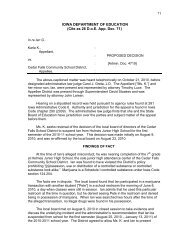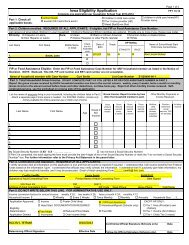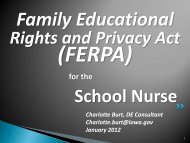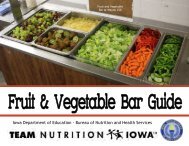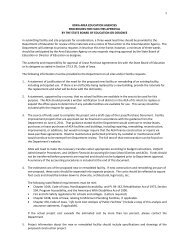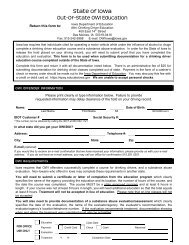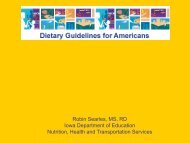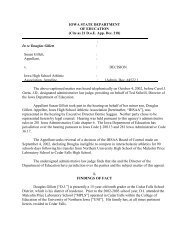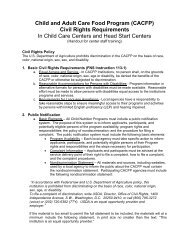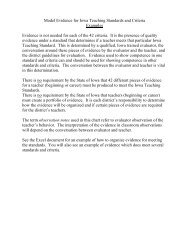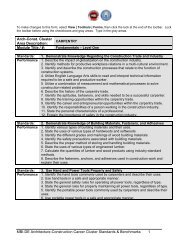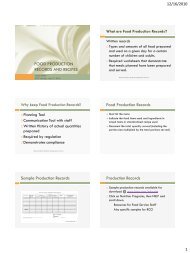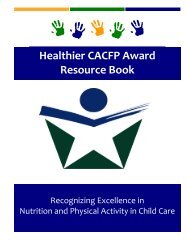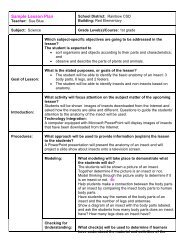Standard 2: Draw conclusions, make informed decisions, apply ...
Standard 2: Draw conclusions, make informed decisions, apply ...
Standard 2: Draw conclusions, make informed decisions, apply ...
Create successful ePaper yourself
Turn your PDF publications into a flip-book with our unique Google optimized e-Paper software.
<strong>Standard</strong> 2: <strong>Draw</strong> <strong>conclusions</strong>, <strong>make</strong> <strong>informed</strong> <strong>decisions</strong>, <strong>apply</strong> knowledge to newsituations, and create new knowledge.SkillsIndicators2.1.1 Continuean inquiry-basedresearch processby <strong>apply</strong>ingcritical thinkingskills (analysis,synthesis,evaluation,organization) toinformation andknowledge inorder toconstruct newunderstandings,draw<strong>conclusions</strong>, andcreate newknowledge.Iowa CoreContentConcept/SkillReading:Reads for avariety ofpurposes andacross contentareas.Reads withfluency silentlyand aloud tosupportcomprehensionUses a varietyof strategies todevelop andexpand readingvocabularyWriting:Uses aneffectivewriting processEngages in theinformationliteracyGrade LevelBenchmarksKDG-2• Write, draw, orverbalizesupportingdetails.• Answer thequestion,“What is thismostly about?”• Find facts toanswerquestions inmore than onesource.• Notesimilarities anddifferences ininformationfrom differentsources.• Identifysupportingdetails.• Analyze andevaluate newinformationbased onpreviousexperience andknowledge• Complete theKWL processISTEDispositionsoptionalResponsibilities(optional)Name: Date:School District/Building:1 a1 B1 C1 D4 A4 CDemonstrateflexibility inthe use ofresources yadaptinginformationstrategies toeach specificresource andby seekingadditionalresourceswhen clear<strong>conclusions</strong>cannot bedrawn.Use bothdivergent andconvergentthinking toformulatealternative<strong>conclusions</strong>and test themagainst theevidence.Connectunderstanding ofthe real worldConsider diverseand globalperspectives indrawing<strong>conclusions</strong>Use validinformation andreasoned<strong>conclusions</strong> to<strong>make</strong> ethical<strong>decisions</strong>.Assessment:• Product• Process• Student Self-QuestioningGraphic Organizerfor non-fiction vsfictionKWLWebWritten reportsfrom researchSelf-assessment:accept; reject ormodifyHow can I improve?BIG 6 ProcessEvaluation andsynthesis…organization of informationand presentinginformation. Applyknowledge to newsituations.
process:assess,evaluates andcommunicatesinformation andideas.Adheres toconventionsgenerallyestablished inspelling,punctuation,grammar,usage, syntaxand styleSpeaking:Produces acoherentmessageListening:Listens forinformation andunderstanding.Listens forinterpretation,analysis andevaluationListens toestablish,maintain andenhanceGrade 3-5:Answer thequestion, “What isthis mostly about?”• Use differentclues(placement intext, signalwords, focalpoint ofillustration) todetermineimportant ideasin illustrationsand text.• Identify factsand details thatsupport mainideas.• Restate andrespond withdetailedanswers tofactualquestions.• Find similar bigideas in morethan onesource.• Question thedifferencesbetweensources andseek additionalsources toresolve.• MakeEmploy acritical stancein drawing<strong>conclusions</strong>bydemonstrating that thepattern ofevidenceleads to adecision orconclusionDetermine how toact on information;accept, reject ormodifyReflect onsystematic processand assess forcompletion ofinvestigationRecognize newknowledge andunderstandingDevelop directionsfor futureinvestigationsName: Date:School District/Building:
elationshipsViewing:Uses a varietyof strategies tointerpret visualmediaApplies avariety ofcriteria toevaluateinformationalmediainferences withguidance.•Grade 6-8:• Compare andcontrastinformationfound indifferentsources.• Assess theimportance ofideas bycomparingtheir treatmentacross texts.• Identify mainideas and findsupportingexamples,definitions, anddetails.• Analyzedifferent pointsof viewdiscovered indifferentsources.• Determinepatterns anddiscrepanciesby comparingand combininginformationavailable indifferentsources.• InterpretinformationName: Date:School District/Building:
and ideas bydefining,classifying, andinferring frominformation intext.Grade 9-12• Identify main,supporting, andconflictinginformation usingmultiple sourcesto supportinterpretation orpoint of view.Make and explaininferences aboutmain ideas.• Criticallyexamine andanalyzerelevantinformationfrom a varietyof sources todiscoverrelationshipsand patternsamong ideas.• If discrepancyin points ofview isdiscovered,continueresearch until itis resolved.Name: Date:School District/Building:
• Build aconceptualframework bysynthesizingideas gatheredfrom multipletexts.• Resolveconflictingevidence orclarify reasonsfor differinginterpretationsof informationand ideas.• Organizeinformationindependently,deciding thestructurebased on therelationshipsamong ideasand generalpatternsdiscovered.2.1.2 Organizeknowledge sothat it is useful.Reading:Uses multipledecodingstrategies toaccurately readwords in text.GRADE K-2Use commonorganizationalpatterns to <strong>make</strong>sense ofinformation(chronologicalorder, main ideaName: Date:School District/Building:1 B1 C3 A3 B3 C3 D4 B
Reads withfluently silentlyand aloud tosupportcomprehensionWriting:Uses aneffectivewriting processUsesknowledge ofpurpose,audience,format andmedium indevelopingwrittencommunicationApplies writingskills andstrategies tocommunicateeffectively in avariety ofgenresSpeaking:Produces acoherentmessagewith supportingideas).Grade 3-5• Organize notesand ideas to formresponses toquestions• Organize theinformation in away that isappropriate forthe assignmentor question.• Create asimple outlineGrade 6-8• Combine andcategorizeinformation byusing anoutline orsemantic webto findconnectionsamong ideas.• Use commonorganizationalpatterns toorganizeinformation(chronologicalorder, causeand effect,compare/contrast) in order toName: Date:School District/Building:
Participates in avariety ofcommunicationsituationsUsesappropriatecontent andconventions forpurpose,audience,occasion andcontextDemonstratesuse ofpresentationskills tocommunicateListening:Listens forinformation andunderstanding.Listens forinterpretation,analysis andevaluationListens toestablish,maintain andenhancerelationshipsdraw<strong>conclusions</strong>.Grade 9-12Use differentorganizationalpatterns asappropriate forpoint of view and<strong>conclusions</strong> (causeand effect,hierarchy,chronology,compare/contrast).Experiment withdevising ownorganizationalstructure.Organizeinformationindependently,deciding thestructure based onthe relationshipsamong ideas andgeneral patternsdiscovered.Name: Date:School District/Building:
2.1.3 Usestrategies todraw <strong>conclusions</strong>from informationand <strong>apply</strong>knowledge tocurricular areas,real-worldsituations, andfurtherinvestigations.Viewing:Applies avariety ofcriteria toevaluateinformationalmediaReading:Reads for avariety ofpurposes andacross contentareas.Reads withfluency silentlyand aloud tosupportcomprehensionUses a varietyof strategies todevelop andexpand readingvocabulary.Writing:Uses aneffectivewriting processUsesknowledge ofpurpose,Grade K-2:• Revisit andcomplete K-W-L or othergraphicorganizer usingthe new ideasthat werelearned duringthe inquiryexperience.• Compare newideas with whatwas known atthe beginningof the inquiry.• Makeinferencesregarding thetopic at theconclusion of atheme orresearchproject withguidance.• <strong>Draw</strong> aconclusionabout the mainidea withguidance.3 A3 B3 C3 D4 DName: Date:School District/Building:
audience,format andmedium indevelopingwrittencommunicationApplies writingskills andstrategies tocommunicateeffectively in avariety ofgenres withvariousaudiencesEngages in theinformationliteracyprocess:accesses,evaluates andcommunicatesinformation andideasSpeaking:Considersaudience andvariables in thespeakingsituationGRADE 3-5• Review ideasheld atbeginning ofinquiry andreflectionscapturedduring notetaking.• Matchinformationfound withquestions andpredictions.• Makeinferencesabout the topicat theconclusion of aresearchproject.• <strong>Draw</strong> aconclusionabout the mainidea.• Identifyconnections tothe curriculumand real worldGRADE 6-8.• Review ideasheld atbeginning ofinquiry andreflectionscapturedduring note-Name: Date:School District/Building:
Produces acoherentmessageParticipates in avariety ofcommunicationsituationsDemonstratesuse ofpresentationskills tocommunicateParticipates inone-on-onesituations andgroup settingsRecognizes thefole ofevaluation andresponse in oralcommunicationListening:Listens forinformation andunderstanding.Listens forinterpretation,analysis andevaluationtaking.• Reflect on howideas changedwith moreinformation.• Compareinformationfound totentative thesisor hypothesis;revisit or revisehypothesis asappropriate.• <strong>Draw</strong><strong>conclusions</strong>based onexplicit andimpliedinformation.• Form opinionsand judgmentsbacked up bysupportingevidence.GRADE 9-12• Identify wheninformationdoes notsupporttentative thesisor hypothesis;gatheradditionalinformation orrevisethesis/hypothesis.• <strong>Draw</strong> clear andName: Date:School District/Building:
Listens toestablish,maintain andenhancerelationshipsViewing:Uses a rang ofstrategies tointerpret visualmediaApplies avariety ofcriteria toevaluateinformationalmediaappropriate<strong>conclusions</strong>supported byevidence andexamples.• Combine ideasandinformation todevelop anddemonstratenewunderstanding.• Recognizemultiplecausations forsame issues orevents.• Applystrategies formakingpersonal andreal worldconnectionswithinformation.• Combineinformationand inferencesto draw<strong>conclusions</strong>and createmeaning.• Develop ownpoint of viewand supportwith evidence.• PresentdifferentName: Date:School District/Building:
perspectiveswith evidencefor each.• Apply newknowledge toreal-worldissues andproblems.2.1.4 Usetechnology andotherinformation toolsto analyze andorganizeinformation.Reading: Usesa variety ofskills andstrategies tocomprehendnon-fiction andinformationaltext.Writing: Usesan effectivewriting processGRADE 2-3Use SearchEngine and useon-linedictionary.Use wordprocessing anddrawing tools tocreate writtenproduct.Use On-lineencyclopedia.3 A3 B3 C3 D6 A6 B6 DUsesknowledge ofpurpose,audience,format andmedium indevelopingwrittencommunicationApplies writingGRADE 4-5Use wordprocessing,drawing tools,presentationsoftware, graphingsoftware, and otherproductivitysoftware toillustrate conceptsand convey ideas.Name: Date:School District/Building:
skills andstrategies tocommunicateeffectively in avariety ofgenres withvariousaudiencesUses writng asa tool forlearningEngages in theinformationliteracyprocess:accesses,evaluates, andcommunicatesinformation andideas.Incorporatestechnology as atool to enhancewritingSpeaking:Produces acoherentmessageDemonstratesGRADE 6-8• Identify and<strong>apply</strong> commonproductivitysoftware andfeatures suchas menus andtoolbars toplan, create,and edit wordprocessingdocuments,spreadsheets,andpresentations•Use interactiveWeb 2.0 tools toparticipate as agroup in analyzingand organizinginformation.GRADE 9-12• Identify and<strong>apply</strong> commonproductivitysoftware andfeatures suchas menus andtoolbars toplan, create,and edit wordprocessingdocuments,spreadsheets,andpresentations.• Use interactiveName: Date:School District/Building:
use ofpresentationskills tocommunicateViewing:Demonstratesan awarenessof the effects ofvisual media onsociety andcultureWeb 2.0 toolsto participateas a group inanalyzing andorganizinginformation.• Usetechnologytools (includingWeb 2.0 tools)to create themostappropriateorganizationalpattern toexpressconnectionsand patterns.• Identify and<strong>apply</strong> commonproductivitysoftware (e.g.,use featuressuch asspellcheckerand thesaurusto ensureaccuracy ofwordprocessingdocuments;use formulasand createcharts inspreadsheets;and insertpictures,movies, soundand charts inpresentationName: Date:School District/Building:
software) toenhancecommunicationto an audience,promoteproductivityand supportcreativity.2.1.5Collaborate withothers toexchange ideas,develop newunderstandings,<strong>make</strong> <strong>decisions</strong>,and solveproblems.Writing:Usesknowledge ofpurpose,audience,format andmedium indevelopingwrittencommunicationEngages in theinformationliteracyprocess:accesses,evaluates andcommunicatesideas andinformationSpeaking:Considersaudience andvariables in theGrade K-2:• Shareinformationand ideas withothers bydiscussion andlistening.• Createindividual orcollaborativeprojects toshare withothers.• Work ingroups tocreate, shareand evaluatesimpleinformationproducts(poster,diorama).Grade 3-5:• Express ownideasappropriatelyand effectivelywhile working2 A2 B2 C2 D4 DName: Date:School District/Building:
speakingsituationParticipates in avariety ofcommunicationsituationsRecognizes therole ofresponse in oralcommunicationParticipates inone-on-one andgroup settingsListening:Listens forinformation andunderstanding.Listens forinterpretation,analysis andevaluationListens toestablish,maintain andenhancerelationshipsin groups toidentify andresolveinformationproblems.• Createindividual orcollaborativeprojects toshare withothers.• Work in groupsto create andevaluateinformationproducts.• Work in groupsto createpictures,images, andcharts fordevelopment ofwordprocessingreports andelectronicpresentations.Grade 6-8:• Participate inproblemsolvingprocess withgroup.• Workcollaborativelyto usetechnology forName: Date:School District/Building:
esearch tomeetinformationneeds.• Work in groupsto create andevaluateproducts thatcommunicateinformationand ideas.• Work in groupsto import andmanipulatepictures,images, andcharts in wordprocessingdocuments,spreadsheets,presentations,Web pages,blogs, andother creativeworks, payingattention tocopyrightprovisions.Grade 9-12:• Participate indiscussion toanalyzeinformationproblems andto suggestsolutions.• Work withName: Date:School District/Building:
others toselect,organize, andintegrateinformationand ideas froma variety ofsources andformats.• Use onlineenvironmentsor othercollaborativetools tofacilitatedesign anddevelopment ofmaterials,models,publications,andpresentations,• Apply utilitiesto edit pictures,images, andcharts;complying withall copyrightprovisions.• Collaboratelocally andremotely withpeers, experts,and others tocollect,produce, andshareinformation.• Work withothers to findName: Date:School District/Building:
solutions toproblemsolvingsituations.2.1.6 Use thewriting process,media and visualliteracy, andtechnology skillsto createproducts thatexpress newunderstandings.Reading:Demonstratesanunderstandingof the writtenlanguage andthe relationshipof letters andwords to thesounds ofspeechWriting:Uses aneffectivewriting processUsesknowledge ofpurpose,audience,format andmedium indevelopingwrittencommunicationGrade K-2:• Create aproduct with abeginning,middle, andend.• Use basicgrammarconventions.• Incorporatewriting andoral skills todevelop aproduct orperformance.• Use pictures tocommunicatenewinformationand ideas.• Revise workwith peer orteacherguidance.• Follow steps ofwriting processmodeled bylibrarian orteacher: prewriting,drafting,revising,4B6A6B6DName: Date:School District/Building:
Applies writingskills andstrategies tocommunicateeffectively in avariety ofgenres withvariousaudiencesUses writing asa tool forlearningEngages in theinformationliteracyprocess:accesses,evaluates andcommunicatesinformation andideasIs able to writeon demandAdheres toconventionsgenerallyestablished inspelling,punctuation,grammar,editing,publishing.• Use basicgrammarconventions.• Identify thenames ofsources used.• Make changesbased onteacher/librarian feedback andsuggestions.• Use multipleintelligences tocreate endproducts.Grade 3-5:• Use pre-writingto brainstormideas for mosteffective wayto present<strong>conclusions</strong>.• Determineaudiencebefore creatingproduct.• Draft thepresentation/product followingan outline ofideas and addsupportingdetails.• Create aproduct with aName: Date:School District/Building:
usage, syntaxand styleIncorporatestechnology as atool to enhancewritingSpeaking:Participates in avariety ofcommunicationsituationsParticipatesappropriately inone-on-one andgroup settingsDemonstratesuse ofpresenationskills tocommunicateViewing:Demonstratesan awarenessof the effects ofvisual media onsociety andcultureUnderstandsbeginning,middle, andend.• Use strategiesfor revisionoutlined byteacher orlibrarian.• Modify andrevise ownwork based onfeedback fromothers.• Check forcorrectnessandcompleteness.• Cite all sourcesused accordingto modelprovided byteacher orlibrarian.Select and presentcreative productsin a variety offormats.Grade 6-8:• Use pre-writingto discoveralternate waysto present<strong>conclusions</strong>.• Decidepresentationform based onName: Date:School District/Building:
how literaryforms can berepresented invisualnarrativesaudience andpurpose.• Useinformation tocreate originaland creativeproducts.• Draft thepresentation/product followinga semanticweb or outlineand addsupportingdetails fromnotes.• Communicateboth main andsupportingpoints in theproduct.• Follow andbuild onrevisionstrategiessuggested byteacher orlibrarian.• Edit forgrammar andlanguageconventions.• Cite all sourcesused.• Assess ownproduct anddevelop a fewideas forimprovement.Name: Date:School District/Building:
Grade 9-12• Use pre-writingto discovermost effectiveway to present<strong>conclusions</strong>.• Decidepresentationform based oneffectivecommunicationof point of viewor purpose.• Draft thepresentation/product topresentargument,point of view,interpretation,or new modelmosteffectively withsupportingevidence.• Create maps,charts, tables,diagrams,graphs, andother formatsto presentideas andinformation.• Expandformats toincludemultimedia, e-Name: Date:School District/Building:
mail, software,podcasts,blogs, wikis,Web pages,spreadsheetsand databases.• Revise basedon selfassessment,teacherfeedback, andpeer feedback.• Edit forgrammar,languageconventions,and style• Cite all sourcesused accordingto styleformats.• “Publish” finalproduct.• Evaluate theproduct andprocessthroughout thework and <strong>make</strong>revisions whennecessary.• Express ownideas throughcreativeproducts in avariety offormats• Use the mostappropriateformat, tone,Name: Date:School District/Building:
and language tocommunicateideas clearly todifferentaudiences.• Use pre-writingto discovermost effectiveway to present<strong>conclusions</strong>.• Decidepresentationform based oneffectivecommunicationof point of viewor purpose.• Draft thepresentation/product topresentargument,point of view,interpretation,or new modelmosteffectively withsupportingevidence.• Create maps,charts, tables,diagrams,graphs, andother formatsto presentideas andinformation.• Expandformats toName: Date:School District/Building:
includemultimedia, e-mail, software,podcasts,blogs, wikis,Web pages,spreadsheetsand databases.• Revise basedon selfassessment,teacherfeedback, andpeer feedback.• Edit forgrammar,languageconventions,and style• Cite all sourcesused accordingto styleformats.• “Publish” finalproduct.• Evaluate theproduct andprocessthroughout thework and <strong>make</strong>revisions whennecessary.• Express ownideas throughcreativeproducts in avariety offormatsName: Date:School District/Building:




